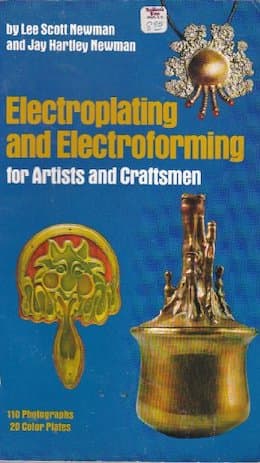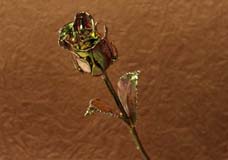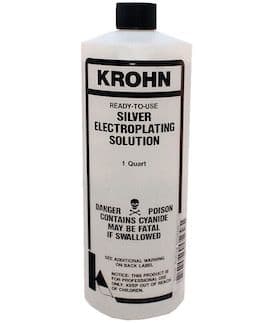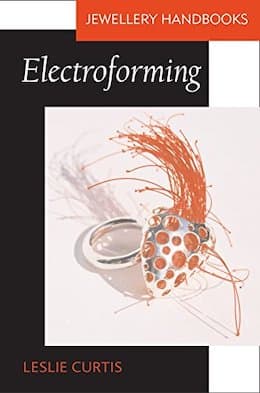
Curated with aloha by
Ted Mooney, P.E. RET

The authoritative public forum
for Metal Finishing 1989-2025

-----
Gold/Silver plating of natural objects Q&A
Q. Hi
Thanks for info. I want to learn how to silver plate shells I find on beach with natural holes in them already in Scotland. I have brawn a blank on training courses I could attend.
I wanted to make some keepsakes for kids, and maybe sell a few. Healthy wee business going out finding objects and then turning them into pendants or key chains.
- Western Isles of Scotland
April 3, 2024
A. Hi Marion,
If you can settle for copper plating rather than silver it will be easier, cheaper, and safer. Just go to youtube and search for 'copper electroforming' for lots of instructional videos. But basically you clean the shell, then metallize it with graphite or metallic paint or specialty metallizing solutions, then you electroplate it, and then probably lacquer it to retard tarnishing and prolong the life.
The problem with silver plating, besides the expense, is that it usually necessitates plating solutions based on deadly cyanide, which really aren't appropriate for hobbyists. You can buy non-cyanide silver plating solutions but they are costly and finicky and, although the color is probably 'good enough', it's not quite right. So please do you early experiments and learning with copper plating before moving on to silver :-)
Luck & Regards,

Ted Mooney, P.E. RET
Striving to live Aloha
finishing.com - Pine Beach, New Jersey
A. Very good book on that subject: Electroforming by Leslie Curtis; London 2004 ⇨
Copper plate your objects and then you can silver or gold plate them. You can use ferrocyanide based gold and silver plating solutions. Potassium ferrocyanide is nontoxic cyanide compound!
Hope it helps and good luck!
- Cerovski vrh Croatia
April 4, 2024
A. Excellent presentation on 19th century electroforming technology,Metropolitan Museum in New York, 2012.
- Cerovski vrh Croatia
April 5, 2024
⇩ Related postings, oldest first ⇩
Q. I'm retired and living in England. Some time ago I saw some beautiful jewelry made by gold or silver plating natural objects such as skeletonized plant leaves, insects and the like. I would like to do this in the garage as a hobby but I can find no info on this process in England . Any help advice or guidance on this matter would be greatly appreciated. Many thanks.
Fred C [last name deleted for privacy by Editor]retired - England
2003
A. My own opinion is that electroplating may not be a real good garage hobby because of the hazardous chemicals, Fred. But if you have some artistic ability and wish to acquire some skill and experience, we have an FAQ on this subject to get you started if you wish. Good luck.

Ted Mooney, P.E.
Striving to live Aloha
finishing.com - Pine Beach, New Jersey
Q. I have similar questions regarding this process though I am not interested in doing it myself. How do I go about finding someone who offers this type of a service? And what would you typically pay?
Meagan K [last name deleted for privacy by Editor]- Brooklyn, New York
2003
A. If you want one particular item of yours plated in such a fashion, Meagan, it would be quite expensive due to labor cost; but you can just post an RFQ on this site and see if plating shops respond to you.
But there are people who plate flowers and leaves and sell them as jewelry, gifts, or Christmas tree ornaments available at catalog prices.
Places which, as of this writing, appear to offer plated natural items include fourleafclover.com, ronchudy.com, canadiangifts.com, wynbrier.com, 24kgoldenroses.com, www.artmartgifts.com, and nature's design [Los Angeles]. Best of luck.

Ted Mooney, P.E.
Striving to live Aloha
finishing.com - Pine Beach, New Jersey
Ed. note Dec. 2014: We've struck through those suggestions which appear to no longer be in business. Which goes to show that while finishing.com is a good place for technical Q&A's, search engines like Google are for 'live' searches and are a better tool for sourcing info.
Q. Can anyone assist me in setting up a small unit where I can transform gold on natural objects.
Sachin S [last name deleted for privacy by Editor]- New Delhi, India
2004
A. Hi, Sachin. Have you had a chance to read the FAQ yet? I think it will help!
If you want to retain a consultant for this, start with our Consultants Directory please. If you are looking for additional online help, please try to describe what your situation is (experience level in electroplating, etc.), and see if you can phrase your questions in terms of what is already explained in the FAQ. Thanks!
Good luck.

Ted Mooney, P.E.
Striving to live Aloha
finishing.com - Pine Beach, New Jersey
Q. I bought some plated natural-object (skeletal leaves, pine cones, shells) jewelry from a store near Mendicino, CA about 20 years ago. Your suggestion of GoldenRoses.com ⇩ is about the closest I've seen, but not quite as artistic. Can you think of any other resources? Thanks.
- Los Altos, California, US
2005
Ed. note: Sorry, that link is broken. This site is intended for permanent reference so it's a poor place for sourcing info like that because most posted sources will be out of business when most readers see the posting :-)
Sorry, googling with patience is better for sourcing info.
A. There is so much info on the net that most of us have to give it a quick scan rather than a careful read, David, but please slowly reread this thread because we actually already tracked down and listed 8 places, not one, but most are now no longer in business.
Thanks.

Ted Mooney, P.E.
Striving to live Aloha
finishing.com - Pine Beach, New Jersey
2005
A. I do what everyone is talking about and that is electroforming ... Electro plating is for metal on metal ... Electroforming is metal on natural or organic items like leaves, pine cones, sea horses, sand dollars, gemstones and or anything you want to cover in gold, copper, silver and rhodium.

- irvine, California
2007
A. Hi, Jim! Yes, what you do is electroforming. But I must nitpick "for the record" because people often come to this site for metal finishing definitions. Electroforming actually means that the electrolytically deposited metal comprises an object rather than a coating on an object.
Thus the metal deposited onto plastic circuit boards and plastic car emblems is still called "electroplating", even though the substrate is organic; and bellows & waveguides & record stampers are "electroforms" even though they may have been created by plating onto a metal substrate and then being separated from it.
Perhaps the best definition is that if the plating layer is free-standing, rather than adhering to an object, the plated layer is an object itself and an electroform.

Ted Mooney, P.E.
Striving to live Aloha
finishing.com - Pine Beach, New Jersey
2007
Q. I am the Operations Manager for a small jewelry business. We routinely use silver-plated resin beads in the manufacture of our jewelry. However, our caster/plater cannot seem to be timely with their shipments. Additionally, we would like to expand our business to include organic items (such as plated leaves) and small batches of plated vintage beads (which would be expensive to do on a few-per basis).
I have had some success with copper then silver plate over conductive paint, but the process is long and tedious and I don't always get the detail or results I want.
I understand there is a process where I can mix 1/4 oz silver nitrate with 5 oz of water and 5 oz of isopropyl alcohol
⇦ this on
eBay or
Amazon [affil links] , then spray or dip the object. After drying, by exposing it to chemical "fumes", the coating is converted to silver sulfide (which can then be plated or sealed).
Significant time searching this site and others has not revealed what kind of silver nitrate to use (purity? crystals? Solution?). Additionally, the MSDS indicates silver nitrate is explosive if mixed with alcohol and should never be mixed with water. Several e-mails to potential suppliers have produced no usable information.
Is anyone familiar with this process who would be willing to share their knowledge/experience? My desire is for a relatively safe process that would be inexpensive and effective for small scale work.
Any assistance is greatly appreciated!
Jewelry Mfg & Sales - Landenberg, Pennsylvania, USA
2007
A. I think you are referring to the process that I would call "2-part silvering", Bruce. In the simplest approach, a 2-headed spray gun simultaneously sprays silver nitrate and a reducing agent that converts the soluble silver nitrate to a thin film of silver metal. You may wish to buy a proprietary process because some of the traditional reducing agents (like formaldelhyde) are carcinogenic. But I understand sugar can be used too. The search term "brashear process" may help you. Good luck.

Ted Mooney, P.E.
Striving to live Aloha
finishing.com - Pine Beach, New Jersey
Q. I would like to do electroforming myself... is there any hope for me? Can I buy a basic kit somewhere? I want to turn beautiful natural objects (seeds, leaves, etc.) into metal. I'd rather do this myself than pay someone else to do it.
Adrian Bussonesart student, industrial designer, jeweler - Boston, Massachusetts
January 8, 2008
by Jay H. Newman

on AbeBooks
or eBay or
Amazon
(affil links)
A. Hello, Adrian. You are an art student and a jeweler, so you have two important things strongly in your favor! Many inquirers miss the fact that such items are works of art, and artistic talent is an important ingredient :-)
See if your library has this book ⇨
or look on youtube for 'electroforming' videos.
Good luck.

Ted Mooney, P.E.
Striving to live Aloha
finishing.com - Pine Beach, New Jersey
Q. Fred from England was asking about the skeleton of leaves, or lacey looking leaves. What is the process, that will take a fresh leaf to that lace-like look?
Brenda Sonne- Bardstown, Kentucky, USA
August 22, 2008
Q. Hi...
Is there a listing of places that offer electroforming services on organic objects? Thank you for any help you can give. Aloha!
- Kailua, Hawaii
October 28, 2010
A. Hi, Traci. Sorry, but I'm not aware of any such list or any organization that would be likely to have such a list. A number of places make standard items like silver plated leaves, gold plated orchids and roses, bronze plated shoes, etc.; we listed eight, and you can probably find others with google. But I don't know any that let you pick the item, and then plate it for you. I wish at least one would advertise here where people are looking. Meanwhile you might try to find Jim D'Andrea or the company "Enchanted Gold" listed in our FAQ on the subject. Best of luck.
Regards,

Ted Mooney, P.E.
Striving to live Aloha
finishing.com - Pine Beach, New Jersey
A. I sell real leaf jewelry and gifts which are made for me. We have a nice selection. Retail prices range from $19.95 to $35.95 depending on the item
Thanks for your information on this page.
- Custer, Washington USA
Q. Which type of chemical can be used for metallic plating of the flower so that it can't get damaged and can be further used for silver plating... please answer me soon

Sarawut Sigh
manufacturer - New Delhi, Delhi & India
Q. I have recently started electroplating leaves, my question is; how do I create the iridescent gold color? I was told once that is was a mixture of both copper and gold, if so, how is this done and where do find plates of gold to use? Thank you.
Aaron KingHobbyist - Denver Colorado USA
March 17, 2011
A. Hi, Aaron.
I'm not sure what you mean by "iridescent" gold -- can you e-mail a photo?
It's not impossible to gold plate using a plate of gold as the anode, but it's not typical for a number of reasons. Usually you would buy a gold plating solution from companies like Technic or Gold Touch [a finishing.com supporting advertiser]. Good luck.
Regards,

Ted Mooney, P.E.
Striving to live Aloha
finishing.com - Pine Beach, New Jersey
Q. Hi
I have also recently started electroplating leaves, and I was wondering how to create the 'iridescent' copper effect.


I have no idea even where to start on this, so any advice would be appreciated.
Jessica Penfold- Adelaide, South Australia, Australia
August 20, 2012
Q. This is my deal here. I bought my girl friend a pine cone that was iridescent copper finished and thought to myself after that I sure would like to make those so I collected a ton of baby pine cones and copper then I realized I have no clue how to put a metal onto a plant. Can you please help me out; I'm not a chemist. I can't read the numbers of chemicals but I am smart enough to follow directions if you catch my drift :)
I'm a certified diesel technician so I can figure it and get the resources I need please. Thank you.
- Longview, Washington
August 20, 2013
A. Hi folks.
Iridescence and gold/copper plating are actually two independent things.
'Iridescence' applies not just to gold or copper plating, but also to carnival glass, the rainbow colored oil slicks on puddles, and other things. Iridescence is what develops when very thin transparent or translucent films of oil or oxides are present. Part of the light hitting it bounces off the top of the film; part of it goes into the film and bounces off the object (or bottom of the thin film). The portions of the light taking the shorter and the longer paths are out of sync and 'interfere' with each other, amplifying some wavelengths (colors) of the light and suppressing others.
But it seems that what is pictured here is not that sort of carnival glass iridescence' :-)
It looks like there is no copper in the center, just the leaf and lacquer. And on the veins there is heavy copper. I can only guess that the metallizing paint/ink
⇦ this on
eBay
or
Amazon [affil links] was put on in this pattern, perhaps with a brush on the veins, and then a light spatter elsewhere?
Regards,

Ted Mooney, P.E. RET
Striving to live Aloha
finishing.com - Pine Beach, New Jersey
A. Hello,
I was looking up for information on ELECTROFORMING and your page was really helpful. I found this other page, which explains HOW TO do the process and it seems doable.
Thank you, once again, and here www.ehow.com/how_8726954_electroform-leaf.html is what I found that could come in handy.
Mafalda
- Lisbon, Portugal
October 20, 2011
Hi, Mafalda. Thanks! Please mention an interesting factoid from that link; many links go bad in short order, and then the posting would offer no substance, just a broken link :-)
What did you find from that link that was especially interesting to you? Thanks again!
Regards,

Ted Mooney, P.E.
Striving to live Aloha
finishing.com - Pine Beach, New Jersey
Q. Hello
I have recently gotten into electroplating as a hobby, and so far have had considerable success in plating coins. I am able to get a nice, bright coating on them, if a bit dark-looking around the edges.
However, I have been trying very hard to electroplate organic things such as leaves as well. So far my process is to seal a leaf in spray lacquer, then paint it with conductive silver paint which I got out of a circuit drawing pen
⇦ this on
eBay
or
Amazon [affil links] . I'll then attach the crocodile clip to the leaf, put it in the solution, and turn the battery pack on. So far, I've been leaving it in for about 5 minutes - the coin only took about 30 seconds to a minute - and yet NOTHING is happening, at all. Am I not leaving it in long enough, considering how long it took the coin to plate, or am I doing something else wrong? I'm getting really frustrated with this now, I've tried lots of things and done a lot of research into solutions, and yet nothing seems to be working.
Hobbyist - Adelaide, South Australia, Australia
October 3, 2012
A. Try next link:
www.ganoksin.com/borisat/nenam/electroforming.htm
Very good and reliable source of info (and there you can find more articles on electroforming too).
Hope it helps and good luck!
- Cerovski vrh Croatia
Gold plating/electroforming of rice! Help!
Q. Hello plating people! I am an artist and researcher working at the University of Brighton.
I have come up with the bright idea of wanting to gold plate a tonne of rice (50 million grains actually) if anyone was interested I would be very happy to explain my thinking. Please ask.
I know that at the very least this is a difficult task and I thought that you guys would have some advice for me.
My understanding is that I would have to coat them in some sort of epoxy resin first, I imagine that I would use some sort of centrifugal machine (like they use to coat sweets) to evenly cover them and dry them separately.
I am not fixed on this process and would appreciate advice.
Then the plating? Or I believe electroforming. I would love to hear any ideas that you might have.
Thank you in advance for anyway you might help me.
Artist - England
November 29, 2017
Hi Elizabeth
An interesting and challenging project.
Rice comes in a wide range of shapes and sizes but taking an average and sparing you the maths 1 tonne has a surface area of about 4,400 sq m (almost exactly an acre!)
A one micron thick layer on a square metre is 1 cc. Gold has a density of 19.3 g/cc so you are looking at roughly 85 Kg of gold. The price today is over £30/g
So your project will cost over £2,500,000 plus the considerable processing cost. You will also need to factor in security and insurance costs, and rice at about £400 per tonne
Alternatively you may consider an old but clean concrete mixer and a few aerosol cans of gold paint. I would forget the epoxy unless you have a convenient outlet for a one tonne block of solid rice.

Geoff Smith
Hampshire, England
A. When I first read the header I thought, wow he wants to gold plate rice? Well very possible indeed (if it was a handful of rice)...
The rice needs to be coated first with a sealer; you can then proceed with electroless Nickel/Cobalt and then immersion gold.
Good luck,
- Managua, Nicaragua
Q, A, or Comment on THIS thread -or- Start a NEW Thread

